Particle methods for hydrodynamics
光滑粒子法

光滑粒子法光滑粒子法(SmoothedParticleHydrodynamics,SPH)是一种属于流体动力学计算方法,是一种模拟流体行为的数值方法,它通过将流体模拟成一组称为粒子的点来解决流体动力学中的复杂问题。
SPH 技术可以用于对一定范围内的流体运动进行模拟,从而实现更复杂的流体动力学的分析和计算。
SPH方法基于之前开发的有限体积法和有限元法,它使用粒子而不是空间网格来描述流体;有限体积法则使用空间网格来描述流体。
SPH方法利用粒子模拟流体,它要求对流体的状态变量(如流态、密度和压力)进行插值,从而实现对流体进行建模。
由于SPH技术可以有效处理复杂的流体动力学工程问题,因此在90年代末,随着计算资源的发展,它被越来越多的工程师和学者应用于各种流体动力学仿真和研究中。
SPH方法在航空航天、火箭工程、水力学研究、细菌运动、流体沉积等领域均有广泛应用,且在流体动力学模拟方面拥有非常好的表现。
SPH法的基本思想是将流体模拟成一组称为粒子的点,每个粒子由位置、速度、压力等变量描述。
SPH技术可以用于定义和模拟流体的渗流、细节混合、质量转移、凝结及维持等行为。
SPH的主要优点是可以准确的模拟复杂的流体动力学现象,如涡湍流、低Reynolds 数流动等,并且可以计算出流体的流动特性,如压力、速度和粘度等。
另外,SPH技术具有很好的并行能力,从而大大减少了计算时间。
根据SPH方法,研究者得以获得流体的压力、速度和粘度等信息,从而改善流体动力学的理论,有效地解决流体动力学中的复杂问题。
SPH方法有助于我们更深入地了解流体物理学和模拟流体动力学,为科学研究提供基础和技术支撑。
因此,光滑粒子法无疑成为流体动力学研究领域的一个重要分支,它为我们更好地理解和模拟流体动力学系统提供了重要依据。
SPH技术可以准确地模拟流体动态行为,它具有较好的并行能力,因此它在流体动力学研究中具有重要的作用。
随着计算技术的发展,SPH技术将发挥更大的作用,推动重要的理论研究和工程应用。
平滑粒子流体动力学

平滑粒子流体动力学平滑粒子流体动力学(Smoothed Particle Hydrodynamics, SPH)是一种基于粒子方法的流体动力学模拟技术。
SPH首次由Lucy在1977年提出,其基本思想是将流体分割成许多小的粒子,然后利用这些粒子来近似描述流体的运动和物理特征。
SPH不需要网格技术,而是建立在物质微元上进行计算,能够描述复杂的流体流动,包括高速流动、非牛顿流体、多相流等。
SPH的基本思想是将流体离散化为小颗粒,形成一个粒子系统,通过计算单个颗粒的物理特征和粒子之间的相互作用来模拟流体的动力学行为。
每个粒子都有一个质量、一个坐标和一个速度,并且每个粒子都可以互动起来,粒子之间的相对距离、速度和质量共同决定了它们之间的相互作用。
这种相互作用可以通过一些基本的力学和物理规则来描述,例如压力、重力、黏性、表面张力和涡旋等。
根据这些规则,计算每个粒子所受到的力和加速度,并通过积分运动方程来解决系统的运动状态。
SPH模拟的主要优点是适用于非常复杂的流体流动情况,例如高速水流、液体撞击和多相流动,而且无需事先生成网格,适用于不规则边界和复杂的几何形状。
此外,SPH还可以简单地实现多 GPU 并行计算,以提高计算速度,使其适用于大规模流体动力学仿真。
因此,SPH已被广泛应用于空气动力学、壳体爆炸物理学、海洋工程学、生物物理学等领域的流体模拟和分析。
然而,SPH模拟也存在一些限制和挑战。
在模拟复杂的流体流动时,需要大量的粒子来近似描述流体,这会产生显著的计算复杂度和存储负担。
此外,SPH模拟中的网格自由、随机抽样和违反牛顿定律的特征可能导致数值不稳定性和误差积累,从而影响模拟精度和可靠性。
目前,许多研究人员正在致力于改进SPH算法,提高其计算效率和精度,并推广应用于更广泛的领域。
总的来说,SPH模拟是一种基于粒子方法的流体动力学模拟技术,其简单的数学框架和应用的多个领域,使其成为较为理想的流体动力学仿真方法之一。
SPH介绍

Smoothed-particle hydrodynamicsFrom Wikipedia, the free encyclopediaJump to: navigation, searchSmoothed-particle hydrodynamics (SPH)is a computational method used for simulating fluid flows. It has been used in many fields of research, including astrophysics, ballistics, volcanology, and oceanography. It is a mesh-free Lagrangian method(where the co-ordinates move with the fluid), and the resolution of the method can easily be adjusted with respect to variables such as the density.Contents[hide]∙ 1 Method∙ 2 Uses in astrophysics∙ 3 Uses in fluid simulation∙ 4 Uses in solid mechanics∙ 5 References∙ 6 External links∙7 Software[edit] MethodThe smoothed-particle hydrodynamics (SPH) method works by dividing the fluid into a set of discrete elements, referred to as particles. These particles have a spatial distance (known as the "smoothing length",typically represented in equations by h), over which their properties are "smoothed" by a kernel function. This means that the physical quantity of any particle can be obtained by summing the relevant properties of all the particles which lie within the range of the kernel. For example, using Monaghan's popular cubic spline kernel the temperature at position depends on the temperatures of all the particles within a radial distance2h of .The contributions of each particle to a property are weighted according to their distance from the particle of interest, and their density.Mathematically, this is governed by the kernel function (symbol W). Kernel functions commonly used include the Gaussian function and the cubic spline. The latter function is exactly zero for particles further away than two smoothing lengths (unlike the Gaussian, where there is a small contribution at any finite distance away). This has the advantage of saving computational effort by not including the relatively minor contributions from distant particles.The equation for any quantity A at any point is given by the equation where m j is the mass of particle j, A j is the value of the quantity A for particle j, ρj is the density associated with particle j, denotes position and W is the kernel function mentioned above. For example, the density of particle i (ρi) can be expressed as:where the summation over j includes all particles in the simulation.Similarly, the spatial derivative of a quantity can be obtained by using integration by parts to shift the del () operator from the physical quantity to the kernel function,Although the size of the smoothing length can be fixed in both space and time, this does not take advantage of the full power of SPH. By assigning each particle its own smoothing length and allowing it to vary with time, the resolution of a simulation can be made to automatically adapt itself depending on local conditions. For example, in a very dense region where many particles are close together the smoothing length can be made relatively short, yielding high spatial resolution. Conversely, in low-density regions where individual particles are far apart and the resolution is low, the smoothing length can be increased, optimising the computation for the regions of interest. Combined with an equation of state and an integrator, SPH can simulate hydrodynamic flows efficiently. However, the traditional artificial viscosity formulation used in SPH tends to smear out shocks and contact discontinuities to a much greater extent than state-of-the-art grid-based schemes.The Lagrangian-based adaptivity of SPH is analogous to the adaptivity present in grid-based adaptive mesh refinement codes, though in the lattercase one can refine the mesh spacing according to any criterion selected by the user. Because it is Lagrangian in nature, SPH is limited to refining based on density alone.Often in astrophysics, one wishes to model self-gravity in addition to pure hydrodynamics. The particle-based nature of SPH makes it ideal to combine with a particle-based gravity solver, for instance tree gravity[1], particle mesh, or particle-particle particle-mesh.[edit] Uses in astrophysicsThe adaptive resolution of smoothed-particle hydrodynamics, combined with its ability to simulate phenomena covering many orders of magnitude, make it ideal for computations in theoretical astrophysics.Simulations of galaxy formation, star formation, stellar collisions, supernovae and meteor impacts are some of the wide variety of astrophysical and cosmological uses of this method.Generally speaking, SPH is used to model hydrodynamic flows, including possible effects of gravity. Incorporating other astrophysical processes which may be important, such as radiative transfer and magnetic fields is an active area of research in the astronomical community, and has had some limited success.[citation needed][edit] Uses in fluid simulationFig. SPH simulation of ocean waves using FLUIDS v.1Smoothed-particle hydrodynamics is being increasingly used to model fluid motion as well. This is due to several benefits over traditionalgrid-based techniques. First, SPH guarantees conservation of mass without extra computation since the particles themselves represent mass. Second, SPH computes pressure from weighted contributions of neighboringparticles rather than by solving linear systems of equations. Finally, unlike grid-base technique which must track fluid boundaries, SPH creates a free surface for two-phase interacting fluids directly since the particles represent the denser fluid (usually water) and empty space represents the lighter fluid (usually air). For these reasons it is possible to simulate fluid motion using SPH in real time. However, both grid-based and SPH techniques still require the generation of renderable free surface geometry using a polygonization technique such as metaballs and marching cubes, point splatting, or "carpet" visualization. For gas dynamics it is more appropriate to use the kernel function itself to produce a rendering of gas column density (e.g. as done in the SPLASH visualisation package).One drawback over grid-based techniques is the need for large numbers of particles to produce simulations of equivalent resolution. In the typical implementation of both uniform grids and SPH particle techniques, many voxels or particles will be used to fill water volumes which are never rendered. However, accuracy can be significantly higher with sophisticated grid-based techniques, especially those coupled with particle methods (such as particle level sets). SPH for fluid simulation is being used increasingly in real-time animation and games where accuracy is not as critical as interactivity.[edit] Uses in solid mechanicsWilliam G. Hoover has used SPH to study impact fracture in solids. Hoover and others use the acronym SPAM (smooth-particle applied mechanics) to refer to the numerical method. The application of smoothed-particle methods to solid mechanics remains a relatively unexplored field.[edit] References1.^"The Parallel k-D Tree Gravity Code"; "PKDGRAV (Parallel K-D treeGRAVity code" use a kd-tree gravity simulation.∙[1] J.J. Monaghan, "An introduction to SPH," Computer Physics Communications, vol. 48, pp. 88–96, 1988.∙[2] Hoover, W. G. (2006). Smooth Particle Applied Mechanics: The State of the Art, World Scientific.∙[3] Impact Modelling with SPH Stellingwerf, R. F., Wingate, C. A., Memorie della Societa Astronomia Italiana, Vol. 65, p. 1117 (1994).∙[4] Amada, T., Imura, M., Yasumuro, Y., Manabe, Y. and Chihara, K.(2004) Particle-based fluid simulation on GPU, in proceedings ofACM Workshop on General-purpose Computing on Graphics Processors (August, 2004, Los Angeles, California).∙[5] Desbrun, M. and Cani, M-P. (1996). Smoothed Particles: a new paradigm for animating highly deformable bodies. In Proceedings of Eurographics Workshop on Computer Animation and Simulation (August 1996, Poitiers, France).∙[6] Harada, T., Koshizuka, S. and Kawaguchi, Y. Smoothed Particle Hydrodynamics on GPUs. In Proceedings of Computer GraphicsInternational (June 2007, Petropolis Brazil).∙[7] Hegeman, K., Carr, N.A. and Miller, G.S.P. Particle-based fluid simulation on the GPU. In Proceedings of International Conference on Computational Science (Reading, UK, May 2006). Proceedingspublished as Lecture Notes in Computer Science v. 3994/2006(Springer-Verlag).∙[8] M. Kelager. (2006) Lagrangian Fluid Dynamics Using Smoothed Particle Hydrodynamics, M. Kelagar (MS Thesis, Univ. Copenhagen).∙[9] Kolb, A. and Cuntz, N. (2005) ] Dynamic particle coupling for GPU-based fluid simulation, A. Kolb and N. Cuntz. In Proceedings of the 18th Symposium on Simulation Techniques (2005) pp. 722–727.∙[10] Liu, G.R. and Liu, M.B. Smoothed Particle Hydrodynamics: a meshfree particle method. Singapore: World Scientific (2003).∙[11] Monaghan, J.J. (1992). Smoothed Particle Hydrodynamics. Ann.Rev. Astron. Astrophys (1992). 30 : 543-74.∙[12] Muller, M., Charypar, D. and Gross, M. ] Particle-based Fluid Simulation for Interactive Applications, In Proceedings ofEurographics/SIGGRAPH Symposium on Computer Animation (2003), eds.D. Breen and M. Lin.∙[13] Vesterlund, M. Simulation and Rendering of a Viscous Fluid Using Smoothed Particle Hydrodynamics, (MS Thesis, Umea University, Sweden).SPH方法光滑粒子流体动力学方法SPH (Smoothed Particle Hydrodynamics)光滑粒子流体动力学方法SPH (Smoothed Particle Hydrodynamics)是近20多年来逐步发展起来的一种无网格方法,该方法的基本思想是将连续的流体(或固体)用相互作用的质点组来描述,各个物质点上承载各种物理量,包括质量、速度等,通过求解质点组的动力学方程和跟踪每个质点的运动轨道,求得整个系统的力学行为。
SPH 方法模拟高速碰撞问题的实例
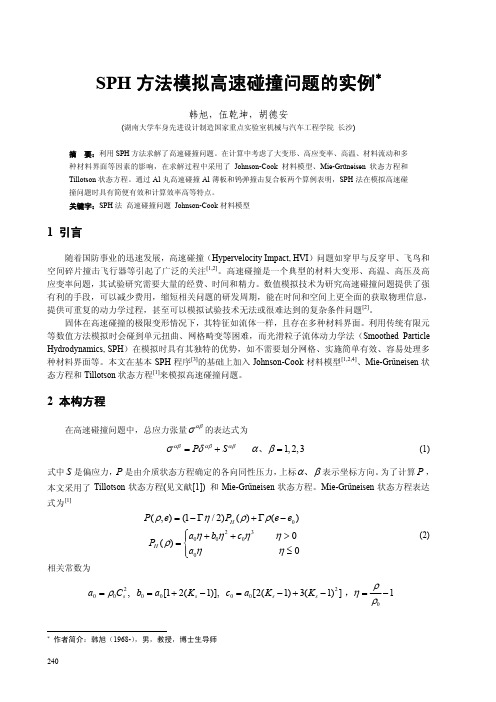
压的作用下,铝丸及其周围基本熔化,形成在高速飞散的碎片云。
4.2 钨弹穿复合板算例
多种材料层叠的复合板在用SPH模拟时具有一定的现实意义。本文建立了一个如图3所示三层夹 水板模型,整个结构的厚度为15mm,中层为水,两侧为钢板,每层厚5mm。为了对比,在相同条件 下计算了厚度为15mm全钢板靶体。计算中采用直径为10mm、长度为20mm的钨弹以1500m/s的速度对 两种靶体分别进行撞击。两种算例粒子初始半径都为0.3846mm,整个模型共有9464个粒子,夹水板 的上下层钢板分别有2704个粒子,中间水层有2704个粒子,钨弹丸有1352个粒子。初始光滑长度为 - 0.3846mm,初始时间步长取10 9s,初始温度设为 20 0C。水按照理想流体计算,相关状态方程和参数 的选取参考了文献[3],钨和钢的材料参数见表1和表2。
(8)
∂Wij 1 αβ αβ Dei 1 N P Pj = ∑ m j ( i2 + 2 + Π ij )(viβ − v β + Si ε i + H i j ) Dt 2 j =1 ρi ρ j ∂xiβ ρi Dxiα = viα Dt
α
(9)
(10)
式中, ρ 、 e 、 v 、 σ i 、 S i 、 ε i 、 Π ij 和 H i 分别为密度、比能量、速度分量、应力分量、人工
P ( ρ , e) = (1 − Γη / 2) PH ( ρ ) + Γρ (e − e0 )
2 3 ⎧ ⎪a η + b0η + c0η PH ( ρ ) = ⎨ 0 ⎪ ⎩a0η
η >0 η≤0
(2)
相关常数为
a0 = ρ0Cs2 , b0 = a0 [1 + 2( K s − 1)], c0 = a0 [2( K s − 1) + 3( K s − 1) 2 ] ,η =
光滑粒子流体力学计算案例
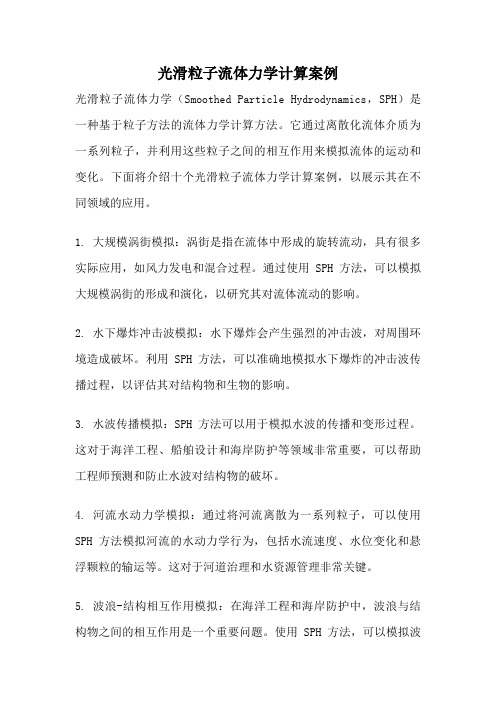
光滑粒子流体力学计算案例光滑粒子流体力学(Smoothed Particle Hydrodynamics,SPH)是一种基于粒子方法的流体力学计算方法。
它通过离散化流体介质为一系列粒子,并利用这些粒子之间的相互作用来模拟流体的运动和变化。
下面将介绍十个光滑粒子流体力学计算案例,以展示其在不同领域的应用。
1. 大规模涡街模拟:涡街是指在流体中形成的旋转流动,具有很多实际应用,如风力发电和混合过程。
通过使用SPH方法,可以模拟大规模涡街的形成和演化,以研究其对流体流动的影响。
2. 水下爆炸冲击波模拟:水下爆炸会产生强烈的冲击波,对周围环境造成破坏。
利用SPH方法,可以准确地模拟水下爆炸的冲击波传播过程,以评估其对结构物和生物的影响。
3. 水波传播模拟:SPH方法可以用于模拟水波的传播和变形过程。
这对于海洋工程、船舶设计和海岸防护等领域非常重要,可以帮助工程师预测和防止水波对结构物的破坏。
4. 河流水动力学模拟:通过将河流离散为一系列粒子,可以使用SPH方法模拟河流的水动力学行为,包括水流速度、水位变化和悬浮颗粒的输运等。
这对于河道治理和水资源管理非常关键。
5. 波浪-结构相互作用模拟:在海洋工程和海岸防护中,波浪与结构物之间的相互作用是一个重要问题。
使用SPH方法,可以模拟波浪与结构物的相互作用,以评估结构物的稳定性和安全性。
6. 粘弹性流体模拟:SPH方法不仅适用于模拟牛顿流体,还可以模拟粘弹性流体,如聚合物溶液和纳米流体。
这对于研究材料的流变性质和设计新型流体材料非常有价值。
7. 燃烧过程模拟:SPH方法可以模拟燃烧过程中的流体动力学和热传导行为。
这对于燃烧工程和火灾安全评估非常重要,可以帮助改进燃烧设备和制定有效的火灾防护措施。
8. 多相流模拟:多相流是指同时存在多种不同相态的流体,如气液两相流和固液两相流。
SPH方法可以模拟多相流的复杂流动行为,如气泡运动、颗粒悬浮和液滴破裂等。
9. 气体动力学模拟:SPH方法可以用于模拟气体动力学过程,如爆炸、喷射和气体流动。
光滑粒子法与分子动力学关系
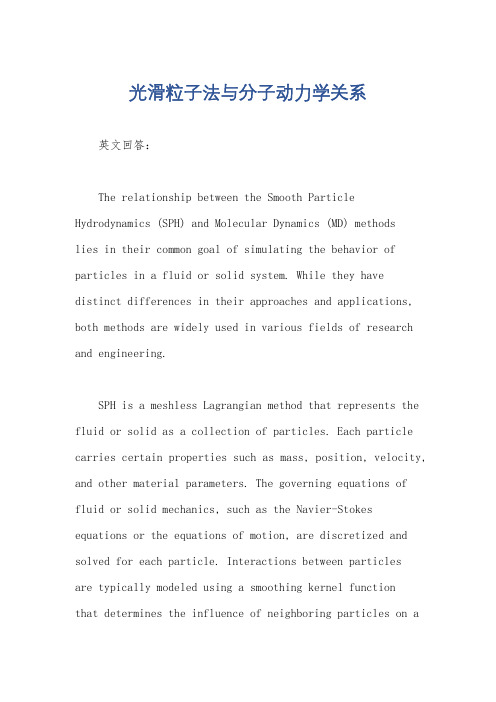
光滑粒子法与分子动力学关系英文回答:The relationship between the Smooth Particle Hydrodynamics (SPH) and Molecular Dynamics (MD) methodslies in their common goal of simulating the behavior of particles in a fluid or solid system. While they havedistinct differences in their approaches and applications, both methods are widely used in various fields of research and engineering.SPH is a meshless Lagrangian method that represents the fluid or solid as a collection of particles. Each particle carries certain properties such as mass, position, velocity, and other material parameters. The governing equations of fluid or solid mechanics, such as the Navier-Stokes equations or the equations of motion, are discretized and solved for each particle. Interactions between particlesare typically modeled using a smoothing kernel functionthat determines the influence of neighboring particles on agiven particle.MD, on the other hand, is a particle-based method that simulates the motion and interactions of individual atoms or molecules in a system. Each atom or molecule is treated as a separate entity with its own position, velocity, and energy. The forces between atoms or molecules are calculated using interatomic potentials, such as the Lennard-Jones potential or the Coulombic potential. The equations of motion, derived from Newton's laws, are integrated numerically to simulate the time evolution of the system.Despite their different approaches, SPH and MD share some similarities. Both methods are particle-based and rely on the interactions between particles to simulate the behavior of the system. They can both handle complex geometries and boundary conditions, making them suitablefor simulating a wide range of problems. Additionally, both methods can capture phenomena such as fluid flow, heat transfer, and structural deformation.However, there are also significant differences between SPH and MD. SPH is primarily used for simulating fluid flows, such as ocean waves, river flows, and aerodynamics.It is well-suited for problems involving large deformations, free surfaces, and complex fluid-structure interactions. On the other hand, MD is commonly used for studying molecular systems, such as chemical reactions, materials properties, and biomolecular processes. It provides detailedinformation about atomic or molecular interactions and can capture phenomena at the nanoscale.In summary, SPH and MD are two distinct methods for simulating particle behavior in fluid or solid systems. While they have different approaches and applications, they share the common goal of accurately representing the behavior of particles in a given system.中文回答:光滑粒子法(Smooth Particle Hydrodynamics,SPH)和分子动力学(Molecular Dynamics,MD)方法之间的关系在于它们共同致力于模拟流体或固体系统中粒子的行为。
水流对浮体作用的SPH方法模拟_肖潇
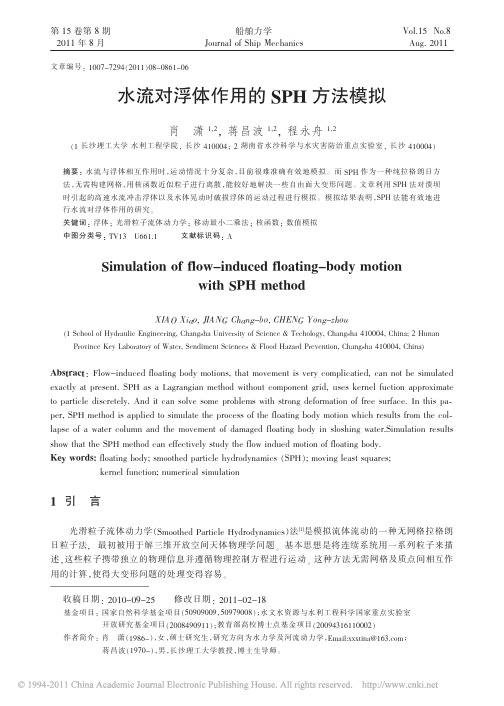
第15卷第8期船舶力学Vol.15No.8 2011年8月Journal of Ship Mechanics Aug.2011文章编号:1007-7294(2011)08-0861-06水流对浮体作用的SPH方法模拟肖潇1,2,蒋昌波1,2,程永舟1,2(1长沙理工大学水利工程学院,长沙410004;2湖南省水沙科学与水灾害防治重点实验室,长沙410004)摘要:水流与浮体相互作用时,运动情况十分复杂,目前很难准确有效地模拟。
而SPH作为一种纯拉格朗日方法,无需构建网格,用核函数近似粒子进行离散,能较好地解决一些自由面大变形问题。
文章利用SPH法对溃坝时引起的高速水流冲击浮体以及水体晃动时破损浮体的运动过程进行模拟。
模拟结果表明,SPH法能有效地进行水流对浮体作用的研究。
关键词:浮体;光滑粒子流体动力学;移动最小二乘法;核函数;数值模拟中图分类号:TV13U661.1文献标识码:ASimulation of flow-induced floating-body motionwith SPH methodXIAO Xiao,JIANG Chang-bo,CHENG Yong-zhou(1School of Hydraulic Engineering,Changsha University of Science&Techology,Changsha410004,China;2Hunan Province Key Laboratory of Water,Sendiment Sciences&Flood Hazard Prevention,Changsha410004,China)Abstract:Flow-induced floating body motions,that movement is very complicatied,can not be simulated exactly at present.SPH as a Lagrangian method without component grid,uses kernel fuction approximate to particle discretely.And it can solve some problems with strong deformation of free surface.In this pa-per,SPH method is applied to simulate the process of the floating body motion which results from the col-lapse of a water column and the movement of damaged floating body in sloshing water.Simulation results show that the SPH method can effectively study the flow indued motion of floating body.Key words:floating body;smoothed particle hydrodynamics(SPH);moving least squares;kernel function;numerical simulation1引言光滑粒子流体动力学(Smoothed Particle Hydrodynamics)法[1]是模拟流体流动的一种无网格拉格朗日粒子法,最初被用于解三维开放空间天体物理学问题。
汽轮机叶片水蚀损伤预测及防水蚀方法研究进展

汽轮机叶片水蚀损伤预测及防水蚀方法研究进展摘要:汽轮机是电力行业的核心动力设备。
火电和核电汽轮机中有大量湿蒸汽级,其中广泛存在湿蒸汽两相流动,凝结水分的出现不仅影响气动效率,还会导致湿蒸汽级叶片水蚀。
随着具有暂歇特性的风能和太阳能等可再生能源的大规模应用,为了保证电网安全稳定运行,需要火电机组承担调峰任务,汽轮机低负荷运行已成为新常态。
同时,随着汽轮机单机容量的不断增大,末级叶片的最大圆周速度已经超过600 m/s,这使汽轮机叶片更容易发生水蚀。
水蚀损伤会导致叶片材料损失和外形变化,造成级效率下降,严重时还可能发生叶片断裂,造成重大运行事故。
此外,叶片减重可能会影响汽轮机转子平衡,引发剧烈振动,严重影响机组的安全运行。
因此,掌握汽轮机叶片水蚀损伤状态,减少或避免损害,对于保证汽轮机的正常运行具有重要意义。
关键词:汽轮机;叶片;水蚀本文总结了水蚀损伤预测和叶片材料防水蚀工艺两个方面的国内外研究进展及相应成果,可为汽轮机叶片防水蚀技术开发、机组运维方案制定等提供参考。
1 水蚀损伤预测水蚀本质上是高速水滴撞击叶片表面导致的材料损伤。
汽轮机湿蒸汽级中通流部分的水滴会附着在静叶表面形成水膜,当水膜发展到一定厚度时被蒸汽撕裂,形成较大的水滴。
由于这些水滴的惯性较大,无法跟随主流离开叶栅通道,因而会以很大的相对速度撞击高速旋转的动叶表面,从而导致叶片水蚀。
为了评价叶片的水蚀状态,很多学者针对水蚀疲劳寿命、叶片表面侵蚀和材料水蚀测试开展了详细的研究。
1.1 水蚀疲劳寿命分析1.1.1 水蚀寿命理论模型建立水滴侵蚀的理论模型,有助于预测材料水蚀的起始与发展速度,为材料表面防护及寿命预测提供基础数据。
建立该模型通常需要开展3个部分的研究:(1)描述和评估水蚀的条件,包括冲击载荷等参数;(2)材料力学性能及其对冲击的响应;(3)采用的失效准则。
水蚀条件参数包括撞击速度、水滴尺寸、撞击频率等,根据这些参数可以研究水滴的撞击压力,并由此获得材料的应力应变。
非均匀粒子流体模拟
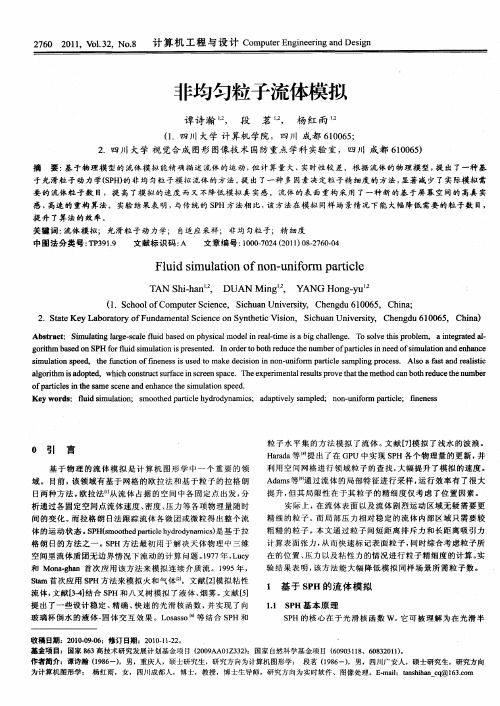
Fl i i u ain o o — n f r p ril ud sm lt f n u io m a t e o n c
T AN h — a 。 S i n DUA N ig h , M n , Y ANG n — u' Ho gy
( .S h o f mp tr ce c , Sc u nUnv ri ,Ch n d 1 0 5 C ia 1 c o l Co ue in e ih a iesy o S t e g u6 0 6 , hn ;
g rt m a e n S oi h b s d o PH r u d smu ai ni r s n e . I r e o hr d c en m b r f a t l s n n e f i lt n a de h c f i of l i lto p e e t d no d r o b t u et u e p ri e e do smu a i n a e s t e h o c i o n n
0 引 言
基 于 物 理 的 流 体 模 拟 是 计 算 机 图 形 学 中 一 个 重 要 的 领
粒 子 水 平 集 的 方 法 模 拟 了 流 体 。 献 [】 拟 了 浅 水 的 波 浪 。 文 7模 H rd 等 提 出 了 在 GP 中实 现 S H 各 个 物 理 量 的 更新 , aaa U P 并 利用 空间网格进行领域粒子的查找 , 幅提升了模拟的速度。 大
s i lt n s e d t ef n t n o n n s s s d t k e iin i o — n f r p ril a l g p o e s Al a t d r a i i mu a i p e , h c i f e e si e ma ed cso n n u i m a t es mp i r c s . o u o i f u o n o c n s a f s l t o n a e sc
pic粒子模拟方法
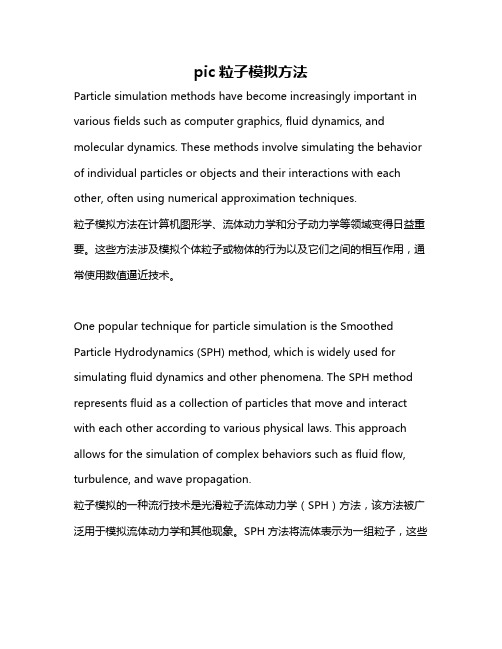
pic粒子模拟方法Particle simulation methods have become increasingly important in various fields such as computer graphics, fluid dynamics, and molecular dynamics. These methods involve simulating the behavior of individual particles or objects and their interactions with each other, often using numerical approximation techniques.粒子模拟方法在计算机图形学、流体动力学和分子动力学等领域变得日益重要。
这些方法涉及模拟个体粒子或物体的行为以及它们之间的相互作用,通常使用数值逼近技术。
One popular technique for particle simulation is the Smoothed Particle Hydrodynamics (SPH) method, which is widely used for simulating fluid dynamics and other phenomena. The SPH method represents fluid as a collection of particles that move and interact with each other according to various physical laws. This approach allows for the simulation of complex behaviors such as fluid flow, turbulence, and wave propagation.粒子模拟的一种流行技术是光滑粒子流体动力学(SPH)方法,该方法被广泛用于模拟流体动力学和其他现象。
粒子流体力学模拟在生物医学中的应用

粒子流体力学模拟在生物医学中的应用粒子流体力学模拟(Particle Fluid Dynamics,简称PFD)是一种通过将流体模拟为大量的微小粒子,来对复杂流体行为进行数值计算和模拟的方法。
近年来,PFD在生物医学领域的应用逐渐受到关注,其在生物医学研究、疾病治疗和医疗器械设计方面展现出了巨大的潜力。
1. 新药筛选与药物输送系统设计传统的药物筛选往往费时费力,且实验条件受限。
在这方面,PFD可以通过模拟药物在体内的输送与代谢过程,加速药物开发过程,减少实验成本,并提供更准确的预测结果。
此外,通过结合生物组织的特性,PFD还可以设计出更高效的药物输送系统,提高药物的生物利用度和疗效。
2. 血液流动和心血管疾病研究粒子流体力学模拟可以对血液流动进行高精度的模拟,帮助研究人员深入了解心血管系统中的血流动力学特性。
通过模拟血流的速度、压力和剪切力分布,可以发现动脉瘤、心脏瓣膜疾病等心血管疾病的形成机制,为临床诊断和治疗提供科学依据。
3. 癌症病理学研究PFD在癌症研究中具有重要的意义。
通过模拟肿瘤细胞的运动和扩散过程,可以揭示肿瘤生长和转移的机理,进而指导癌症的治疗方案和预后评估。
此外,PFD还可以模拟肿瘤血管形成的过程,为抗血管生成治疗策略的制定提供理论支持。
4. 骨骼生物力学研究粒子流体力学模拟在骨骼生物力学研究中的应用有助于我们更好地理解骨骼系统的构成和力学特性,对骨折和骨质疏松等疾病的治疗提供科学依据。
PFD可以模拟骨骼内的力学应力分布,预测骨折的发生和治愈过程,优化骨折治疗策略。
5. 医疗器械设计与优化粒子流体力学模拟还可以应用于医疗器械的设计与优化。
例如,在人工心脏辅助装置的设计中,PFD可以模拟血流在人工心脏辅助装置中的流动情况,评估器械对血液的剪切力、破坏力等影响,并进行参数优化。
这将有助于提高人工心脏辅助装置的性能和安全性。
总而言之,粒子流体力学模拟在生物医学中的应用潜力巨大。
它能够帮助研究人员更深入地了解复杂生物流体环境中的现象和问题,为疾病的诊断、治疗和医疗器械的设计提供科学依据,为生物医学领域的发展带来新的机遇和挑战。
欧拉ddpm 控制方程
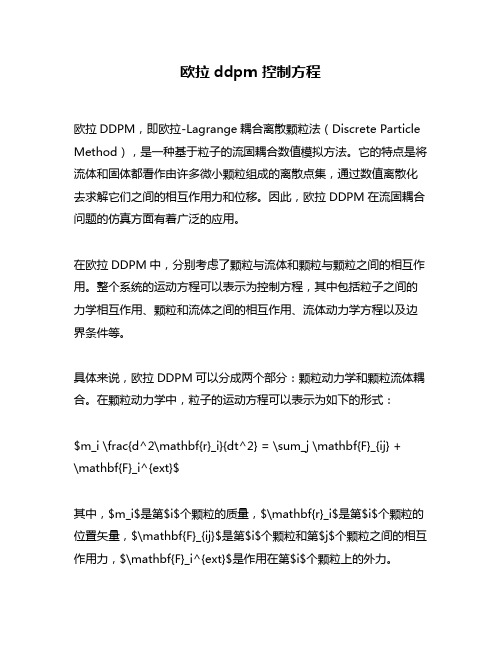
欧拉ddpm 控制方程欧拉DDPM,即欧拉-Lagrange耦合离散颗粒法(Discrete Particle Method),是一种基于粒子的流固耦合数值模拟方法。
它的特点是将流体和固体都看作由许多微小颗粒组成的离散点集,通过数值离散化去求解它们之间的相互作用力和位移。
因此,欧拉DDPM在流固耦合问题的仿真方面有着广泛的应用。
在欧拉DDPM中,分别考虑了颗粒与流体和颗粒与颗粒之间的相互作用。
整个系统的运动方程可以表示为控制方程,其中包括粒子之间的力学相互作用、颗粒和流体之间的相互作用、流体动力学方程以及边界条件等。
具体来说,欧拉DDPM可以分成两个部分:颗粒动力学和颗粒流体耦合。
在颗粒动力学中,粒子的运动方程可以表示为如下的形式:$m_i \frac{d^2\mathbf{r}_i}{dt^2} = \sum_j \mathbf{F}_{ij} +\mathbf{F}_i^{ext}$其中,$m_i$是第$i$个颗粒的质量,$\mathbf{r}_i$是第$i$个颗粒的位置矢量,$\mathbf{F}_{ij}$是第$i$个颗粒和第$j$个颗粒之间的相互作用力,$\mathbf{F}_i^{ext}$是作用在第$i$个颗粒上的外力。
在颗粒流体耦合方面,欧拉DDPM采用了SPH(Smoothed Particle Hydrodynamics)方法来模拟流体运动。
这种方法基于流体微元离散化的方式,通过将流体分割成一系列粒子集合来求解。
在这种方法中,流体的连续性方程和动量方程可以表示为以下形式:$\frac{\partial \rho}{\partial t} + \nabla \cdot (\rho\mathbf{v}) = 0$$\frac{\partial \mathbf{v}}{\partial t} + (\mathbf{v}\cdot\nabla)\mathbf{v} = -\frac{1}{\rho}\nabla p + \nu \nabla^2\mathbf{v} + \frac{\mathbf{f}_{ext}}{\rho}$其中,$\rho$是流体的密度,$\mathbf{v}$是流体的速度,$p$是流体的压强,$\nu$是流体的动力粘度系数,$\mathbf{f}_{ext}$是作用在流体上的外力。
Smoothed Particle Hydrodynamics (SPH)

Vast range of applications: high explosive detonation and explosion micro drop dynamics heat conduction fluid-solid interaction metal forming …
M. Muller, S. Schirm, et al, “Interaction of fluids with deformable solids," Comp. Anim. Virtual Worlds 15: 159-171, 2004. Smoothed Particle Hydrodynamics 12
M.B. Liu, G.R. Liu, K.Y. Lam, "Constructing smoothing functions in smoothed particle hydrodynamics with applications," J Comput Appl Math 155(2): 263–284, 2003.
Fluid with free surfaces Derive the viscosity and pressure force fields from the Navier-Stokes equation Design new special purpose smoothing function
1, x x ' 0, x x '
lim W x x, h x x
h 0
W x x, hdx 1
不同锚固方式双方箱浮防波堤水动力特性的SPH模拟

不同锚固方式双方箱浮防波堤水动力特性的SPH模拟王烨;王永学;贺铭;任冰【摘要】Smoothed particle hydrodynamics (SPH) is used to build a numerical model that simulates the motion response of dual pontoons floating breakwater under wave action. The numerical model calculates its transmission/reflection coefficients and motion response. Numerical simulation accords with the experimental results. In addition, the numerical calculation is carried out to analyze the hydrodynamic characteristics of dual pontoons floating breakwater under the conditions of different incident wave periods and anchoring ways. The numerical calculation results lead to similar transmission coefficients of dual pontoons floating breakwaters in cross and parallel anchoring ways, but the motion range and anchoring force of the former one are slightly larger than that of the latter one.%应用光滑粒子流体动力学(SPH)方法,建立了模拟波浪作用下双方箱浮防波堤运动响应的数值模型,计算了其透射系数、反射系数和运动响应,数值模拟与试验结果符合较好。
光滑粒子流体动力学方法SPH-精品

2020/8/21
f x f x W x x , h d x
N
f x j W x x j , h V j
j1
N
f
j1
xjW
x x j,h
1 j
j V j
N
1
f
j1
xjW
x x j,h
j
mj
N mj j 1 j
f
xjW
x x j,h
粒子近似法
树形搜索法非常适宜求解具有可变光滑长度的问题。这种算法是通过粒子 的位置来构造有序树。一旦树形结构构造起来后,便能高效地搜索最近相邻粒 子。
树形搜索法将最大问题域递归分割成一个个卦限,直到每一个卦限内只包 含一个粒子为止。树形结构构造完成后,即可以开始进行最近相邻粒子搜索。
给定任一粒子i, 并以i为中心,用边长为 2hi的立方体将粒子包围起来,然
强形式 以各种全局或局部加权余量法为统一框架的弱形式
2020/8/21
强形式是直接从微分方程及其定解条件出发,将近似函数及其导 数的估计形式带入基本方程、本构方程和初边值条件中去,联立 方程进行求解。该方法思路简单,便于程序编制,应用范围广泛, 在流体和固体的计算中都有所发展,适用于计算激波、高速冲击、 爆轰、穿甲等冲击动力学问题。但此类算法的精度较低,稳定性 较差,且边界条件的引入比较困难。
光滑函数
光滑函数的性质: 一、正则化条件
Wxx,hdx1
由于光滑函数的积分值等于1,故此条件也称为归一化条件。 二、当光滑长度趋向于零时具有狄拉克函数性质
liW m x x ,h x x
h 0
三、紧支性条件
W xx,h0 xx h
2020/8/21
光滑函数
光滑粒子法 流体
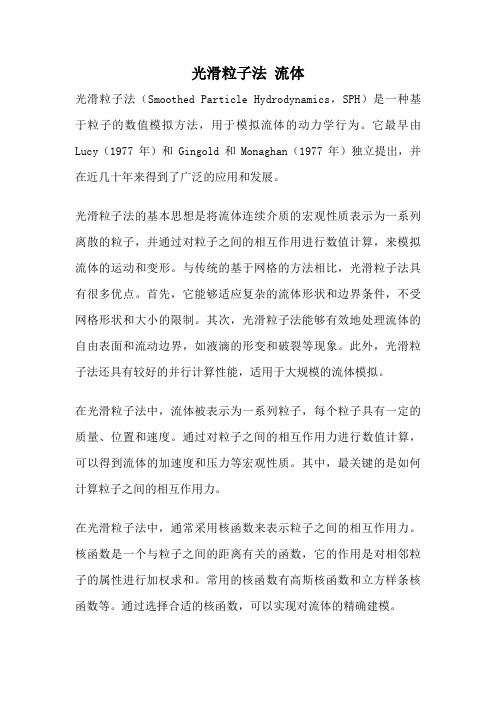
光滑粒子法流体光滑粒子法(Smoothed Particle Hydrodynamics,SPH)是一种基于粒子的数值模拟方法,用于模拟流体的动力学行为。
它最早由Lucy(1977年)和Gingold和Monaghan(1977年)独立提出,并在近几十年来得到了广泛的应用和发展。
光滑粒子法的基本思想是将流体连续介质的宏观性质表示为一系列离散的粒子,并通过对粒子之间的相互作用进行数值计算,来模拟流体的运动和变形。
与传统的基于网格的方法相比,光滑粒子法具有很多优点。
首先,它能够适应复杂的流体形状和边界条件,不受网格形状和大小的限制。
其次,光滑粒子法能够有效地处理流体的自由表面和流动边界,如液滴的形变和破裂等现象。
此外,光滑粒子法还具有较好的并行计算性能,适用于大规模的流体模拟。
在光滑粒子法中,流体被表示为一系列粒子,每个粒子具有一定的质量、位置和速度。
通过对粒子之间的相互作用力进行数值计算,可以得到流体的加速度和压力等宏观性质。
其中,最关键的是如何计算粒子之间的相互作用力。
在光滑粒子法中,通常采用核函数来表示粒子之间的相互作用力。
核函数是一个与粒子之间的距离有关的函数,它的作用是对相邻粒子的属性进行加权求和。
常用的核函数有高斯核函数和立方样条核函数等。
通过选择合适的核函数,可以实现对流体的精确建模。
除了核函数,光滑粒子法还需要考虑粒子之间的相互作用距离。
通常情况下,相互作用距离是通过将流体域分割为一个个小的区域来确定的。
每个粒子只与其相邻的粒子相互作用,而与其他粒子无关。
这种局部的相互作用方式不仅简化了计算,还能够更好地处理流体的局部变形和流动现象。
在计算粒子之间的相互作用力时,除了考虑粒子之间的距离和核函数的作用,还需要考虑流体的物理性质。
通常情况下,流体的密度和压力是通过求解连续性方程和动量方程来得到的。
其中,连续性方程用于描述流体的质量守恒,动量方程用于描述流体的动量守恒。
通过将这两个方程离散化,可以得到粒子之间的相互作用力和压力等宏观性质。
光滑粒子流体动力学方法在二维爆轰中的模拟应用的开题报告

光滑粒子流体动力学方法在二维爆轰中的模拟应用的开题报告一、选题背景与意义为了更深入地了解和掌握多相流体力学的相关知识和技术方法,本文将研究光滑粒子流( Smoothed Particle Hydrodynamics,SPH)方法在二维爆轰中的模拟应用。
目前,爆轰的研究已成为了热力学、化学、物理各个领域中的研究热点之一。
爆轰现象是由于燃烧反应以及物质相变等复杂流体现象引起的,因此对其进行模拟研究时往往需要使用多相流等复杂的流体动力学方法。
SPH作为一种基于粒子的流体动力学方法,可模拟多相流、自由水面、气体以及流固相耦合等问题,因此应用广泛。
本文选取二维爆轰模拟作为研究对象,旨在通过建立SPH模型,对爆轰现象进行数值模拟,进一步研究爆轰现象中的物理、化学过程以及流体特性等方面的问题。
二、研究内容与方法(一)研究内容本文研究内容主要包括以下两个方面:1. 建立SPH模型由于SPH方法基于拉格朗日图像描述流体力学问题,因此需要对流体系统内部的粒子进行数值求解。
通过建立数值求解模型,本文将对SPH方法中的主要参数进行分析和调整,从而最大限度地提高其数值计算效率和计算结果的准确性。
2. 模拟二维爆轰现象本文将使用SPH方法对二维爆轰现象进行数值模拟。
在此基础上,将研究爆轰现象中的物理、化学过程以及流体特性等方面的问题,如爆轰模型、爆轰波传播过程等。
(二)研究方法本文将采用如下研究方法:1. 建立二维爆轰模型本文将通过对爆轰现象进行物理描述,以及对爆轰波传播过程的分析,建立一个二维爆轰模型。
2. 构建SPH模型本文将在建立的二维爆轰模型基础上,构建SPH模型,并对其进行参数调整和优化,从而提高SPH方法的数值计算效率和计算结果的准确性。
3. 二维爆轰数值模拟本文将采用已构建好的SPH模型,对二维爆轰现象进行数值模拟。
在此基础上,将研究爆轰现象中的物理、化学过程以及流体特性等方面的问题,如爆轰模型、爆轰波传播过程等。
SPH方法并行化解决方案
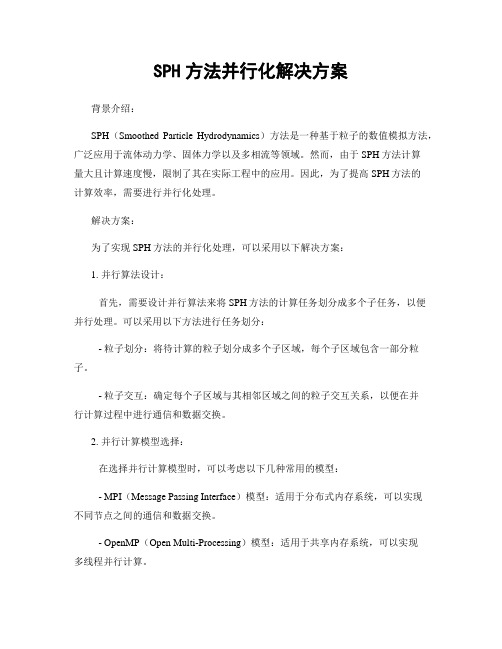
SPH方法并行化解决方案背景介绍:SPH(Smoothed Particle Hydrodynamics)方法是一种基于粒子的数值模拟方法,广泛应用于流体动力学、固体力学以及多相流等领域。
然而,由于SPH方法计算量大且计算速度慢,限制了其在实际工程中的应用。
因此,为了提高SPH方法的计算效率,需要进行并行化处理。
解决方案:为了实现SPH方法的并行化处理,可以采用以下解决方案:1. 并行算法设计:首先,需要设计并行算法来将SPH方法的计算任务划分成多个子任务,以便并行处理。
可以采用以下方法进行任务划分:- 粒子划分:将待计算的粒子划分成多个子区域,每个子区域包含一部分粒子。
- 粒子交互:确定每个子区域与其相邻区域之间的粒子交互关系,以便在并行计算过程中进行通信和数据交换。
2. 并行计算模型选择:在选择并行计算模型时,可以考虑以下几种常用的模型:- MPI(Message Passing Interface)模型:适用于分布式内存系统,可以实现不同节点之间的通信和数据交换。
- OpenMP(Open Multi-Processing)模型:适用于共享内存系统,可以实现多线程并行计算。
- CUDA(Compute Unified Device Architecture)模型:适用于GPU加速计算,可以利用GPU的并行计算能力加速SPH方法的计算过程。
3. 数据并行化处理:在进行SPH方法的并行化处理时,需要考虑数据的并行化处理。
可以采用以下方法进行数据并行化:- 粒子数据划分:将粒子数据划分成多个子数据集,每个子数据集包含一部分粒子的属性信息。
- 数据交换:在并行计算过程中,需要进行粒子数据的交换和同步,以保证计算的正确性和一致性。
4. 并行计算任务调度:在进行SPH方法的并行化处理时,需要进行并行计算任务的调度。
可以采用以下方法进行任务调度:- 动态任务调度:根据不同计算节点的负载情况,动态地将计算任务分配给空闲的计算节点,以实现负载均衡。
水下爆炸冲击载荷的SPH算法研究的开题报告
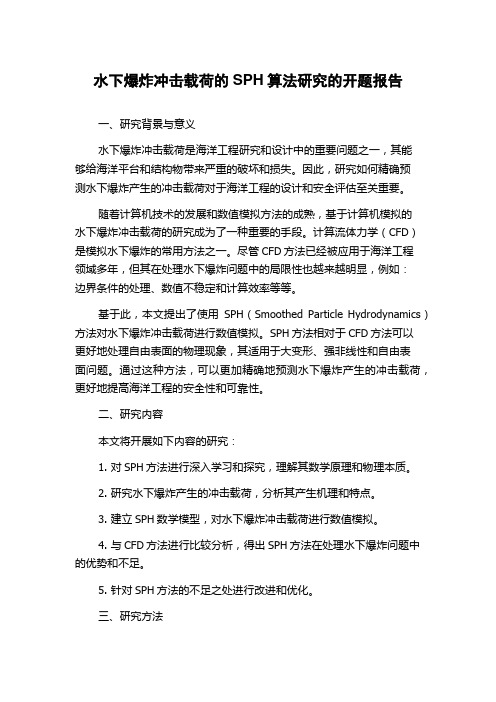
水下爆炸冲击载荷的SPH算法研究的开题报告一、研究背景与意义水下爆炸冲击载荷是海洋工程研究和设计中的重要问题之一,其能够给海洋平台和结构物带来严重的破坏和损失。
因此,研究如何精确预测水下爆炸产生的冲击载荷对于海洋工程的设计和安全评估至关重要。
随着计算机技术的发展和数值模拟方法的成熟,基于计算机模拟的水下爆炸冲击载荷的研究成为了一种重要的手段。
计算流体力学(CFD)是模拟水下爆炸的常用方法之一。
尽管CFD方法已经被应用于海洋工程领域多年,但其在处理水下爆炸问题中的局限性也越来越明显,例如:边界条件的处理、数值不稳定和计算效率等等。
基于此,本文提出了使用SPH(Smoothed Particle Hydrodynamics)方法对水下爆炸冲击载荷进行数值模拟。
SPH方法相对于CFD方法可以更好地处理自由表面的物理现象,其适用于大变形、强非线性和自由表面问题。
通过这种方法,可以更加精确地预测水下爆炸产生的冲击载荷,更好地提高海洋工程的安全性和可靠性。
二、研究内容本文将开展如下内容的研究:1. 对SPH方法进行深入学习和探究,理解其数学原理和物理本质。
2. 研究水下爆炸产生的冲击载荷,分析其产生机理和特点。
3. 建立SPH数学模型,对水下爆炸冲击载荷进行数值模拟。
4. 与CFD方法进行比较分析,得出SPH方法在处理水下爆炸问题中的优势和不足。
5. 针对SPH方法的不足之处进行改进和优化。
三、研究方法本文将采用以下方法进行研究:1. 文献综述法:对SPH方法和水下爆炸冲击载荷的文献进行系统的研究和归纳。
2. 数值模拟法:使用SPH方法对水下爆炸冲击载荷进行数值模拟,分析其计算结果和误差。
3. 算法优化法:针对SPH方法的不足之处,采取优化措施,提高模型的精度和计算效率。
四、研究计划研究周期:2年研究阶段:第一年:1. 学习和理解SPH方法的数学原理和物理本质。
2. 研究水下爆炸冲击载荷,分析其产生机理和特点。
SPH算法简介(一) 数学基础
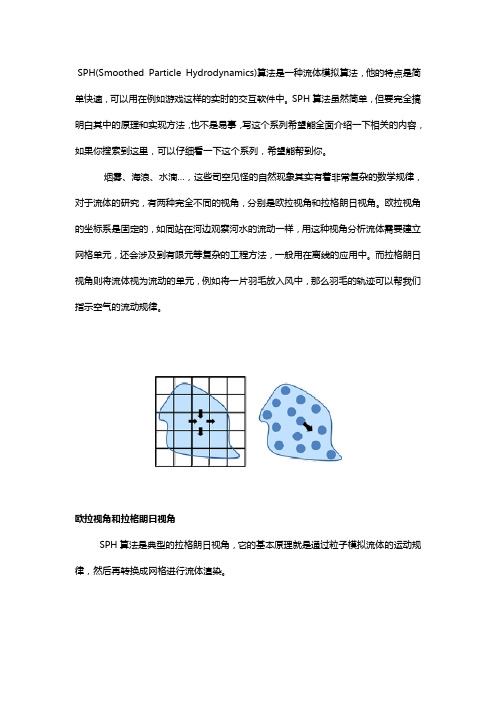
SPH(Smoothed Particle Hydrodynamics)算法是一种流体模拟算法,他的特点是简单快速,可以用在例如游戏这样的实时的交互软件中。
SPH算法虽然简单,但要完全搞明白其中的原理和实现方法,也不是易事,写这个系列希望能全面介绍一下相关的内容,如果你搜索到这里,可以仔细看一下这个系列,希望能帮到你。
烟雾、海浪、水滴…,这些司空见怪的自然现象其实有着非常复杂的数学规律,对于流体的研究,有两种完全不同的视角,分别是欧拉视角和拉格朗日视角。
欧拉视角的坐标系是固定的,如同站在河边观察河水的流动一样,用这种视角分析流体需要建立网格单元,还会涉及到有限元等复杂的工程方法,一般用在离线的应用中。
而拉格朗日视角则将流体视为流动的单元,例如将一片羽毛放入风中,那么羽毛的轨迹可以帮我们指示空气的流动规律。
欧拉视角和拉格朗日视角SPH算法是典型的拉格朗日视角,它的基本原理就是通过粒子模拟流体的运动规律,然后再转换成网格进行流体渲染。
>>在正式开始之前,需要把SPH算法涉及到的相关数学概念介绍一下,这些概念基本上都是大学数学中的内容,所以不用紧张,翻翻书就能想起来。
标量场和矢量场如果空间区域内一点M,都有一个确定的数量f(M),则称这个空间区域内确定了一个标量场,如果空间区域内任意一点M,都有一个确定的向量F(M),则称这空间区域内确定了一个矢量场。
例如,液体中的密度,就是标量场,而速度,就是矢量场偏导数对于多元函数z=f(x,y),定义z在(x0,y0)处相对于x的偏导数为(1.1) 例如,定义z=x2+2xy+y3,那么∂z/∂x=2x+2y, ∂z/∂y=2x+3y2哈密顿算子哈密顿算子在流体力学中是如此重要,以至于很多地方将这个符号作为流体力学的标志,所以这里要着重介绍一下,所谓“算子”,就是那种不能单独存在,必须和其他符号放在一起的一种数学符号,例如微分中的那个“d”。
哈密顿算子的定义如下:(1.2) 哈密顿算子有很多有趣的特性,它本身虽然并不是一个矢量,但很多运算确实可以把它视为一个矢量,例如把它作用在一个标量场A=f(x,y,z)上,那么(1.3) 这个运算可以视为一个矢量和标量的乘法,得到的A是一个矢量场,称为A的“梯度”,顾名思义,梯度的含义就是标量场A在某处变化快慢和方向,比如一个标量场H (x,y)是一座高山在(x,y)处的高度,则H的梯度是该高山在某处陡峭的程度,并且方向指向高处。
- 1、下载文档前请自行甄别文档内容的完整性,平台不提供额外的编辑、内容补充、找答案等附加服务。
- 2、"仅部分预览"的文档,不可在线预览部分如存在完整性等问题,可反馈申请退款(可完整预览的文档不适用该条件!)。
- 3、如文档侵犯您的权益,请联系客服反馈,我们会尽快为您处理(人工客服工作时间:9:00-18:30)。
This review examines particle methods for compressible flow. The original particle method PIC is described. It can be improved by using more efficient interpolation. Appropriate methods for interpolation from a regular grid of points, and foi interpolation from disordered points are described. A general form of PIC is written down, but optimal forms for boundary conditions and the equations are not known. The method for interpolation from disordered points leads to the particle method SPH. This is a pure Lagrangian method which does not require a grid except as an aid to more efficient computing. Particle methods for magnetohydrodynamics based on PIC and on SPH are described.
PARTICLE METHODS FOR HYDRODYNAMICS
J.J. MONAGHAN
Department of mathematics, Monash University. Ciuyton, VK. 3168, A u.ylru/iu
1985
NORTH-HOLLAND
- Amsterdam
Computer Physics Reports North-Holland, Amsterdam
3 (1985) 71Ll24
PARTICLE METHODS J.J. MONAGHAN
Department of Mathematics,
FOR HYDRODYNAMICS
Monash Uniuersit.y, Cla.yton, Vie. 3168. Austruliu
Contents 1. Introduction .................................... ........ 2. One-dimensional PIC .................... 2.1. Equations of motion ......................... ........................ 2.2. Simple generalizations 2.3. Conservation laws for one-dimensional PIC ......... 2.4. A summary of one-dimensional PIC .............. 3. Interpolation ................................... 3.1. Interpolation on a uniform grid ................. 3.2. Basis splines ............................... 3.3. Other interpolation kernels ..................... 3.4. Improving the basis splines .................... 3.5. Improving other kernels ....................... ................. 3.6. Extentions to higher dimensions .......... 3.7. But what if the data points are disordered ..................... 3.8. Examples of interpolation 3.9. Calculating derivatives ........................ 3.10. How to choose h ............................ 3.11. Further possibilities: spatially varying /? ........... 4. Generalized particle methods ........................ 4.1. Generalized PIC equations ..................... 4.2. Conservation laws for generalized PIC ............. 4.3. Analytical discussion of the generalized PIC equations ................ 4.4. Smoothed particle hydrodynamics 5. Artificial viscosity ................................ 5.1. Artificial viscosity for PIC ..................... 5.2. Artificial viscosity for SPH ..................... ........................ 6. Programming considerations .................... 7. Shock tube and collision problems ....... 8. Particle methods for magnetohydrodynamics (MHD) 9. Calculating the gravitational force ..................... ............................... 9.1. Introduction ......................... 9.2. High order methods ...................... 9.3. The multi-grid algorithm ......................... 9.4. Boundary conditions 9.5. Density assignment and force calculation ........... 9.6. Tests .................................... 10. Relativistic particle methods ......................... 10.1. Special relativistic PIC ........................ 10.2. Special relativistic SPH ....................... References ..................................................
difference
disadvantages. materials. motion. distorted. in regions
could not accurateI\ representation ha\-e these disad-
interface but they
and
advecti\,e terms \ antages. moving Harlow’s momentum equations casilv could. motion disadvantages lvith
. . . . . .
. . . . .
. . . . . . . . . . . . . . .
. . . . . . . . . . . . . .
74 75 75 77 78 79 79 79 80 x2 x2 X6 8X x9 92 93 95 95 96 96 97 99 10 1 106 106 107 109 110 111 115 115 116 116 I18 119 120 120 120 122 123
ad\wtic)n The
b> mo\,ing particles rtxiiaining. Moving
thermal
entropy). could
of motion
on an Eulerian and Eulerian
grid. This
device eliminated.
the integration method.
of the rquationx
were calculated handle .Amxlen projectiles. (for problems
on ;I fixed. involving PIC
called PIG’ for particle and his
bv an independent \V;IS eliminated
set of particles. because spatial and robust
be treated accurately
since it onI\ required distortion grid. ‘I he nuniericul properticb.
the equations
Lagrangian of strong
not
ga\‘e tom ;iccurac\ became highly cncrg~~ (or
